Ever wondered if oil-based polyurethane can enhance your water-based stained projects? Discover the surprising truths behind this woodworking mystery!
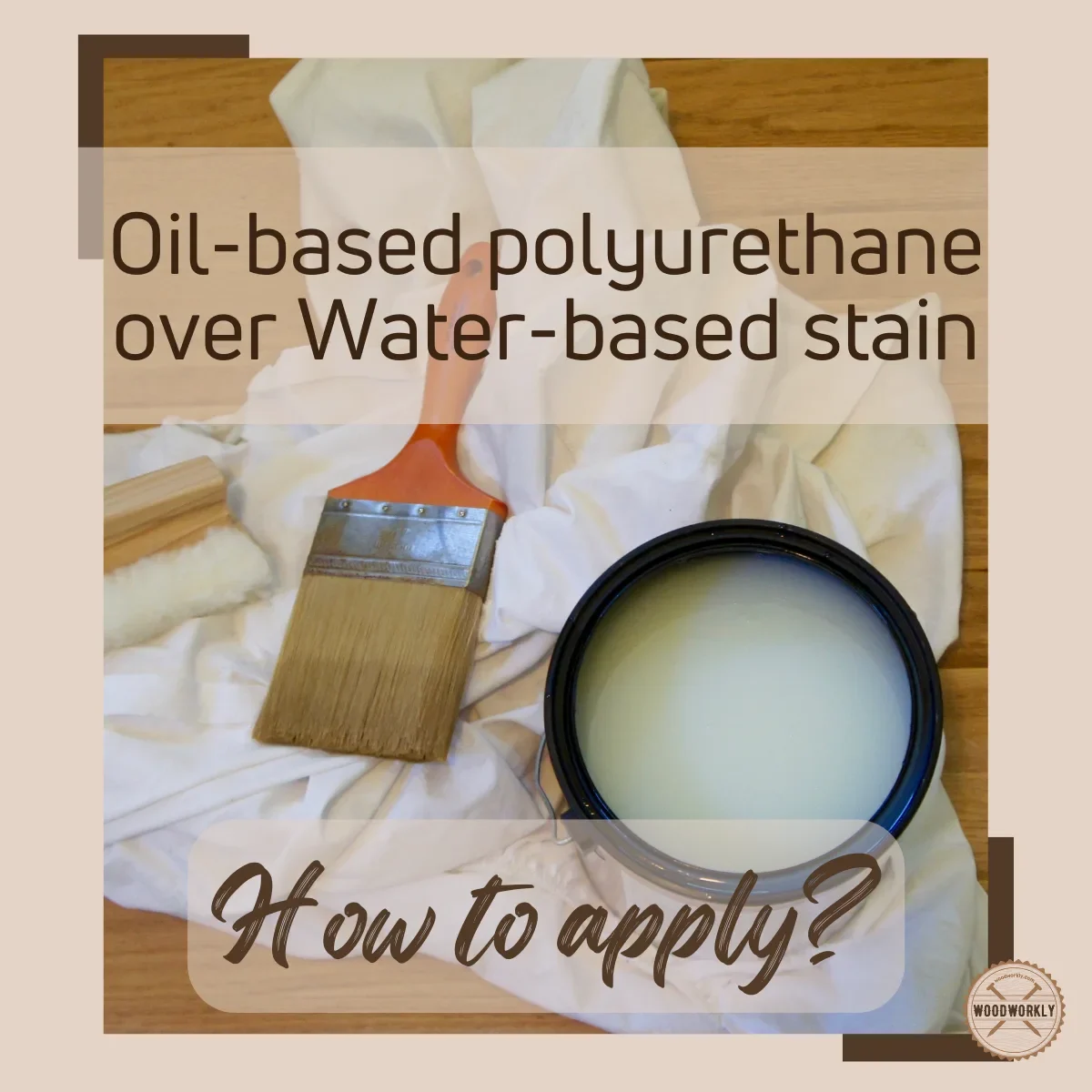
Mixing an oil-based medium with a water-based medium is not possible since they do not mix.
Due to that most people avoid of using applying an oil-based finish over a water-based finish or water-based finish or oil-based finish.
Due to that, I was curious about applying oil-based polyurethane over a water-based stain since I was forgotten to check the medium upon purchase.

I was afraid of scraping by a water-based stained surface and starting over from the beginning with an oil-based stain.
I got advice from professionals, and they explained the myth behind applying different mediums over each other. Here’s what I know.
So, let’s find out, Can you use oil-based polyurethane over water-based stain?
Yes, you can use oil-based polyurethane over water-based stain. Ensure the stain is fully dry, lightly sand the surface for better adhesion, and then apply thin, even coats of oil-based polyurethane, allowing each coat to dry thoroughly before applying the next.
But there’s a lot more to know about using oil-based polyurethane over water-based stain.
In this article, I’ll explore whether can you use oil-based polyurethane over water-based stain and how to do that properly with all the tips and techniques.
Furthermore, I’ll answer some frequently asked questions as well.
Let’s dive in!
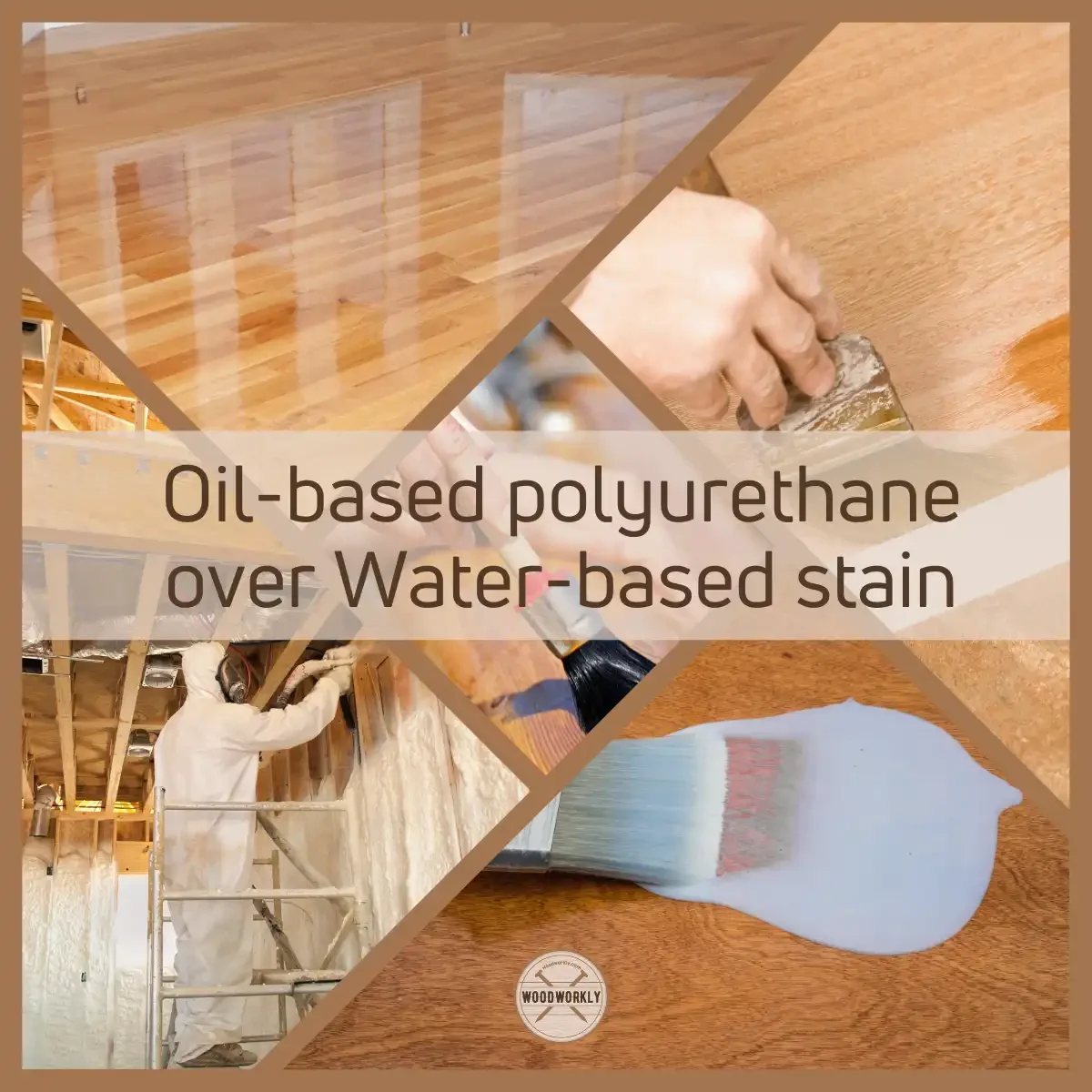
Applying Oil-based Polyurethane Over Water-based Stain
Generally, oil-based medium and water-based medium do not mix. But none says they cannot be applied to each other.
You can apply oil-based polyurethane over water-based stain also water-based polyurethane over oil-based stain. That’s not an issue.
Both stain and polyurethane are excellent finishes with good adhesion they support the upcoming layer to attach on without considering their medium.
Think like this, can you stick two papers together by applying glue over one piece of paper. Yes, you can. Now ask yourself, do they mix? Got it right.
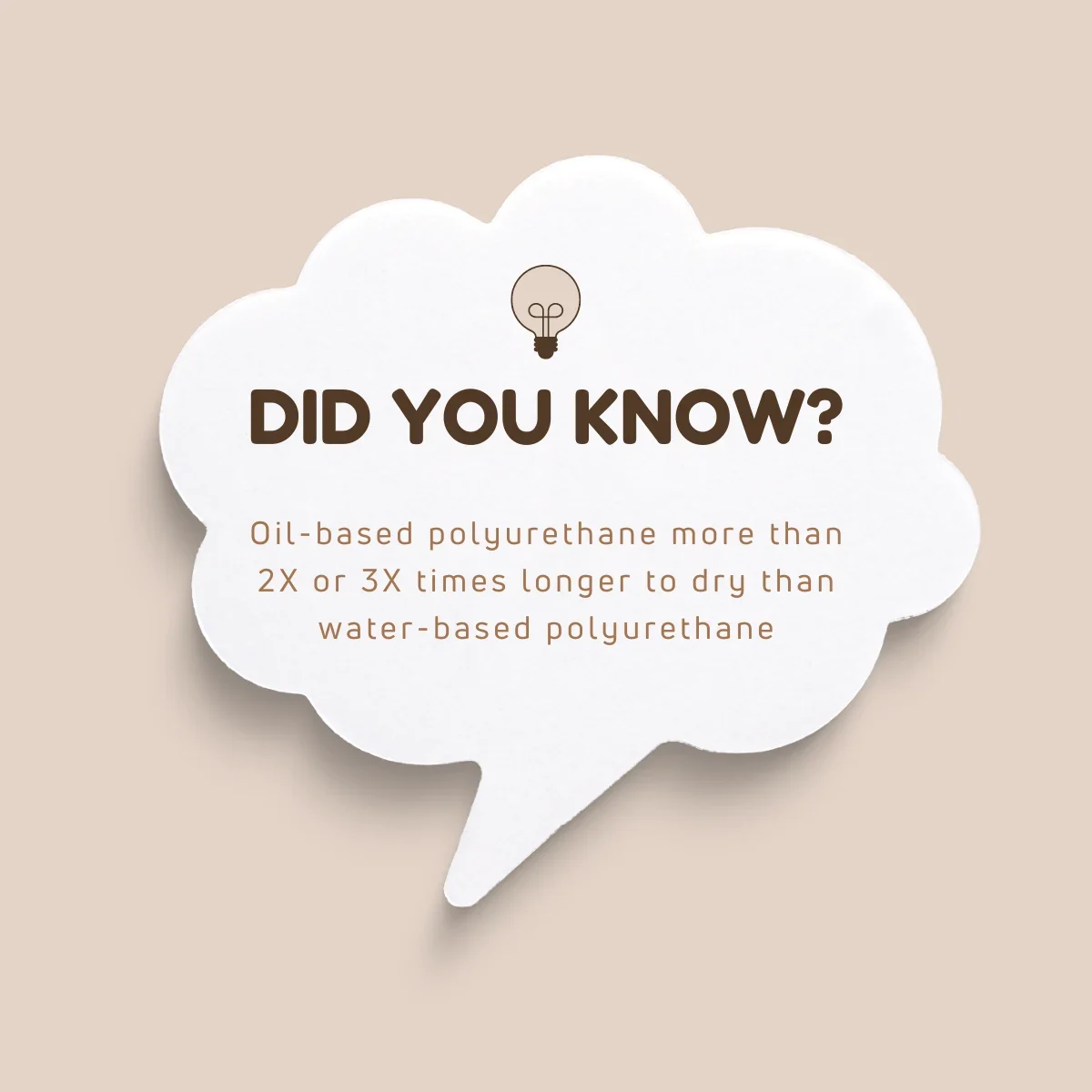
In over to apply over two materials don’t always have to be mixed especially when both or one of them got adhesive properties.
From today onwards, don’t worry about applying one finish over another.
You just have to check whether have good adhesion. If yes, you can apply them over each without considering their medium.
A wood stain helps to highlight the wood grain while enhancing the natural appearance of the wood, it prevents woof from rotting and protects wood from sunlight and moisture.
Polyurethane prevents wood from scratching and denting and provides a glossy smooth surface. Plus, it makes wood waterproof and protects from weather elements.
Read to know, Is Polyurethane Waterproof? Here’s the Truth!
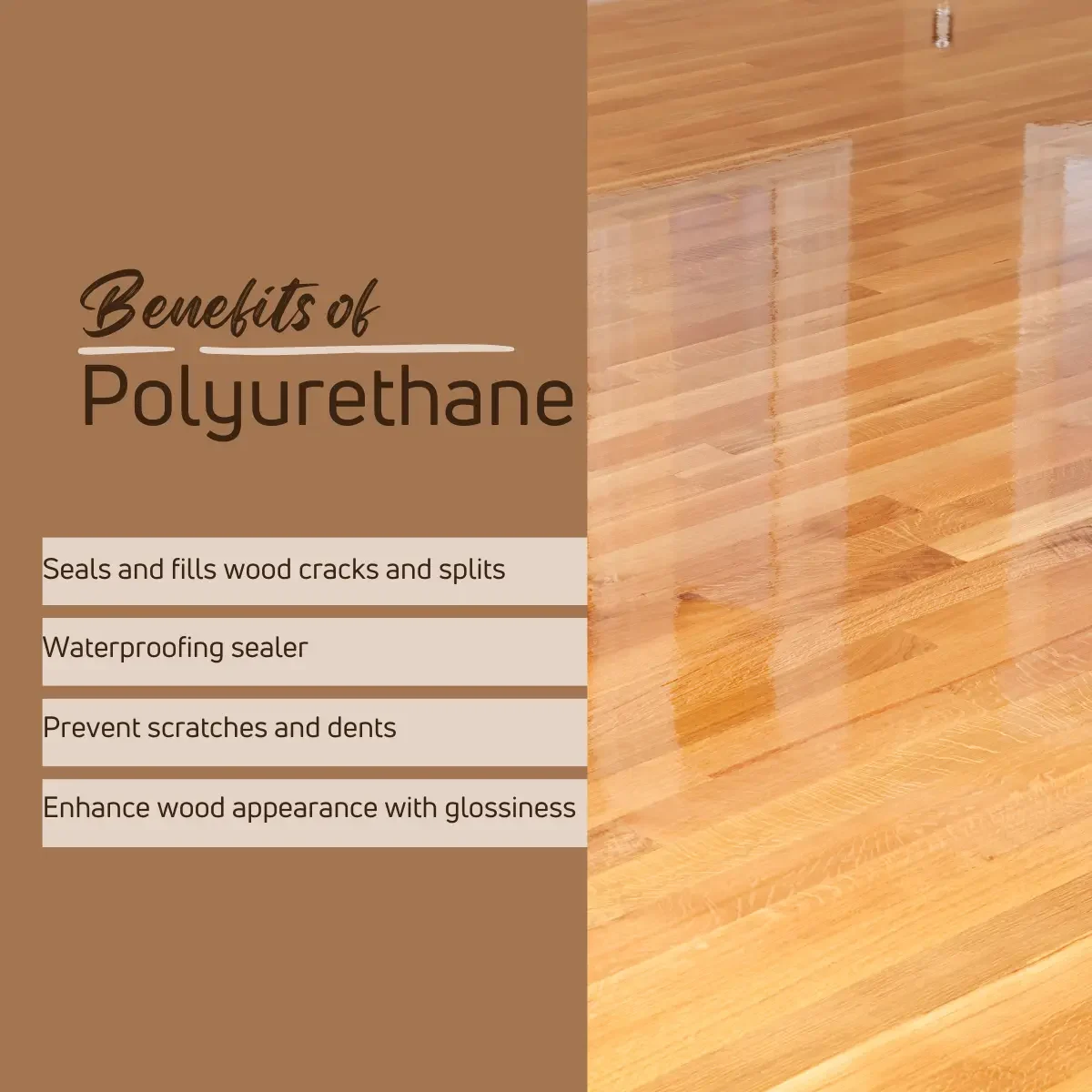
By applying polyurethane over the stain, you’ll be able to get benefits from both finishes at the same time for the same wood.
As long as the stain coat is completely dry, you can apply oil-based polyurethane over a water-based stain.
Apply thin coats of stain and polyurethane for fast and efficient drying and to prevent forming a tacky or splotchy surface.
Sand between each coat for better adhesion between the stain and polyurethane. Having good adhesion is a must to get promising results with a nice and smooth finish.
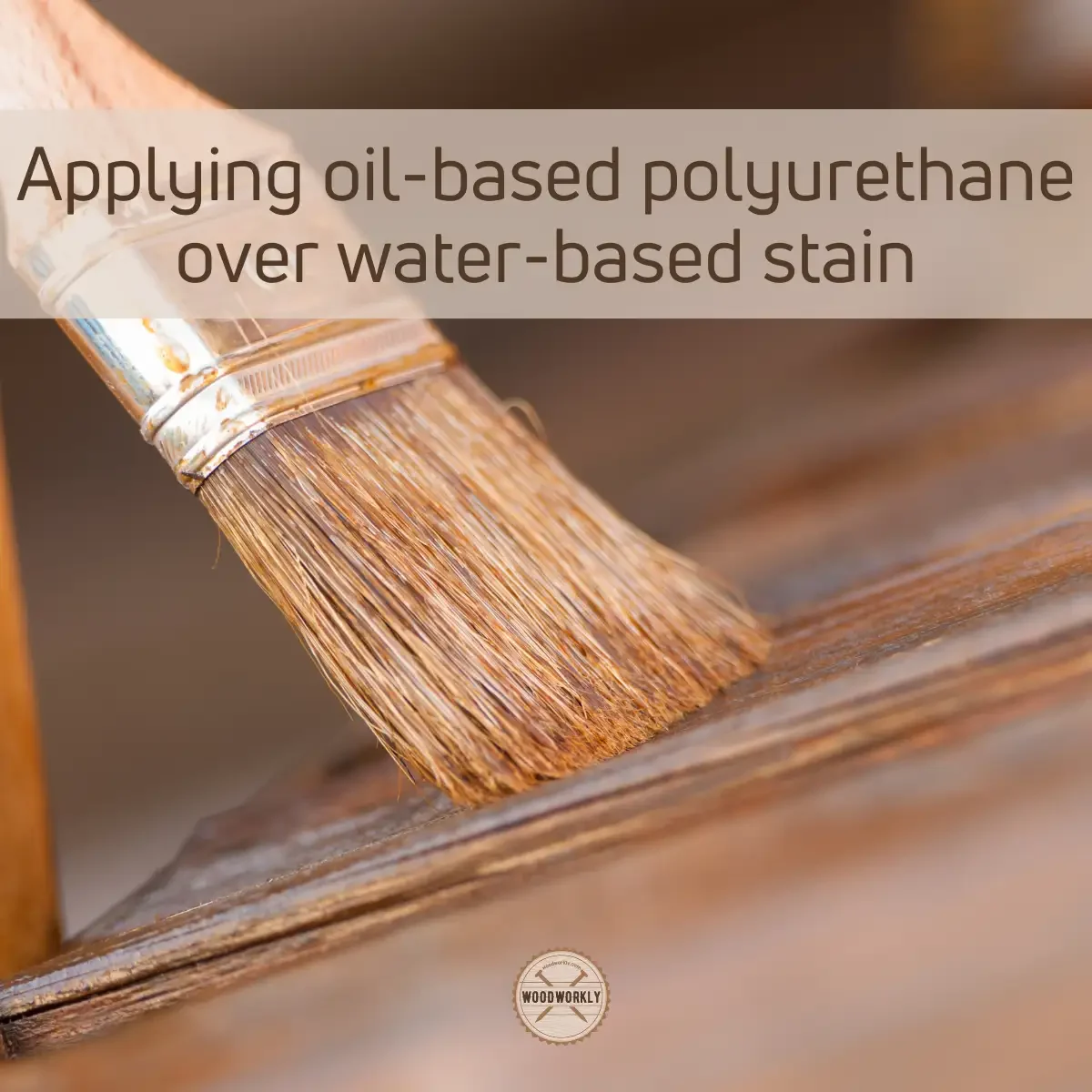
Let’s find out how to apply polyurethane over stain without messing things up.
Tools And Materials To Apply Oil-based Polyurethane Over Water-based Stain
- Oil-based polyurethane can
- Water-based stain can
- 220 grit sandpaper / 120 grit sandpaper
- Dust mask
- Clean rags
- Lin-free tack cloth
- Paintbrush/bristle brush
- Mineral spirits
Check out the Best Brushes For Staining Wood!
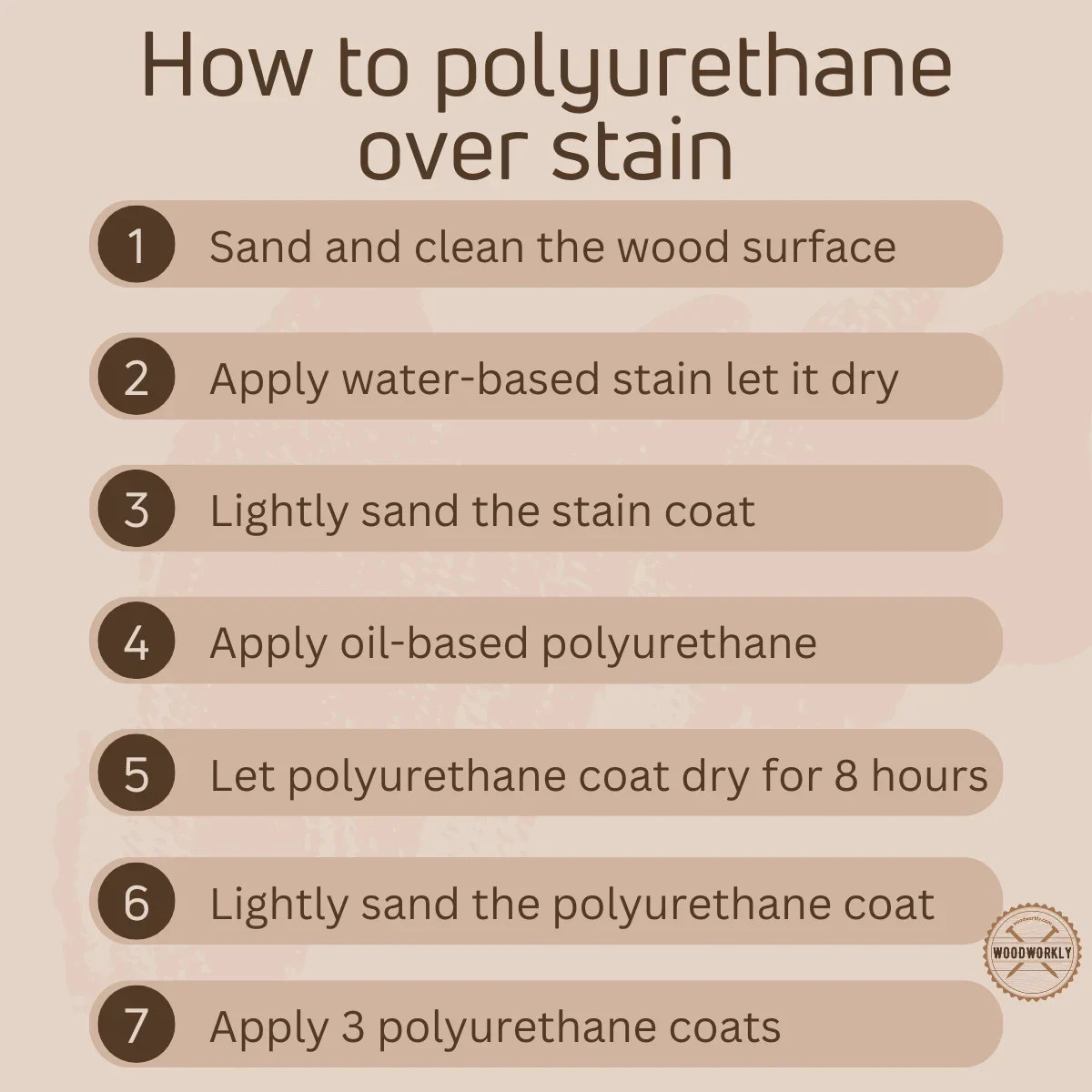
How To Apply Oil-based Polyurethane Over Water-based Stain?
Applying oil-based polyurethane over a water-based stain is easy. Use quality and branded products to get the finish with no contaminations.
Here’re the steps you need to follow when applying oil-based polyurethane over water-based stain,
- Sand and clean the wood
- Apply water-based stain on wood
- Let the stain dry
- Gently sand stain coats
- Test wood surface
- Apply oil-based polyurethane
- Let the polyurethane dry
- Gently sand polyurethane coats
- Apply more polyurethane
Please ignore the 1st, 2nd, and 3rd steps and start from the 4th step onward, if your furniture is already stained and willing to apply polyurethane over it.
Let’s discuss each of the above steps separately to get a clear idea about using polyurethane over stain properly.
1. Sand And Clean The Wood
First, you need to take your wood or furniture to a well-ventilated area because having good air circulation is a must for fast and efficient drying and for your health.
Wood stain and polyurethane contain harsh chemicals and fumes that release upon application. In order to prevent them from inhaling and having proper air circulation is essential to remove them quickly from the working environment.
Exposure to stain and polyurethane chemicals can cause breathing issues, and skin and eye irritations.
Plus, proper ventilation is good for polyurethane and stain coats to dry faster without forming blotchy surfaces.
Then, sand the entire wood surface with 120-grit sandpaper to smoothen the surface by avoiding streaks, bumps, and surface randomness.
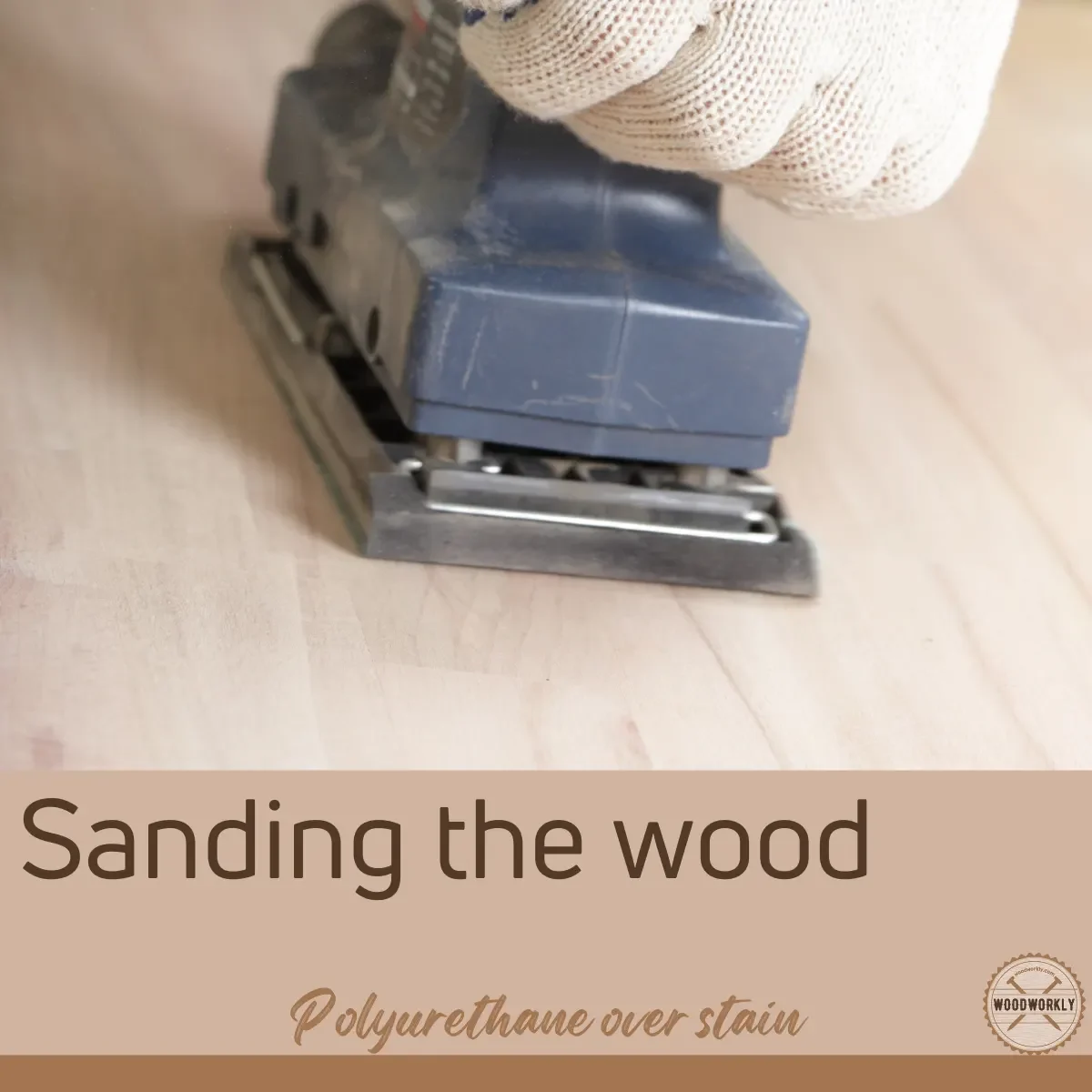
Sand along the direction of the wood grain to avoid forming scratches and dents. Sand with even pressure.
Once you’re done with sanding, clean the wood surface to remove sawdust using a proper dust collection system or by wiping it with clean rags.
Collected sawdust can be used for making fertilizer upon drying.
Cleaning the surface after sanding is a must because sawdust can get trapped inside the stain and polyurethane and cause many troubles.
When the surface is super smooth and clean, you’re good to start the staining job.
2. Apply Water-Based Stain On Wood
Now take the bristle brush or any other applicator and apply a thin coat of water-based stain on the wood along the direction of the wood grain.
Following the wood grain helps to absorb wood stain better and you can get an even surface minimizing wood stain mistakes like blotches and splotches.
Apply wood stain for about 10 to 15 minutes. but this differs on the area you have to cover.
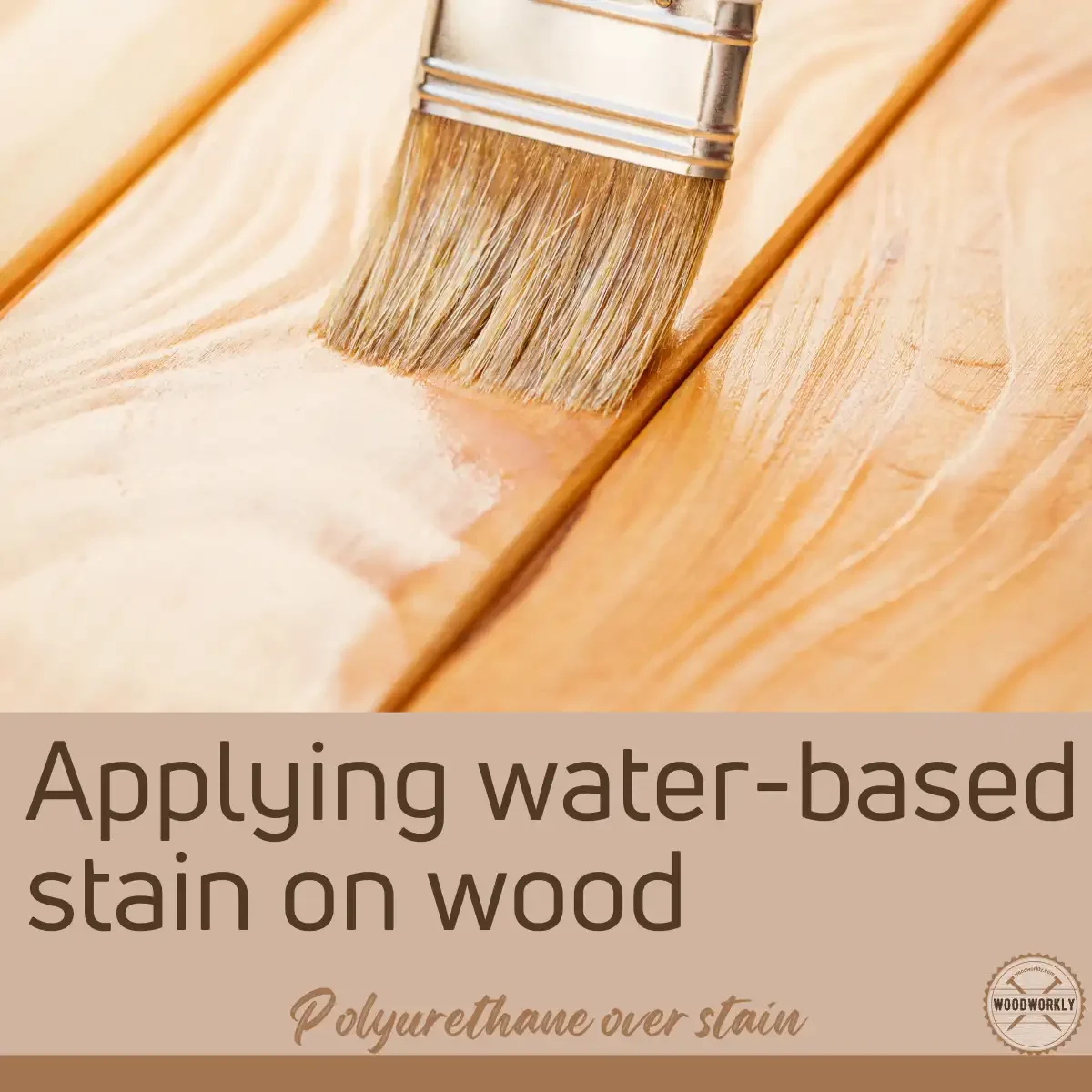
Let the stain coat settle and absorb into the surface for 30 minutes and wipe off the excess using a tack cloth. Excess wipe-off is useful to make a thin coat of stain without blotches.
Don’t overbrush since it can form brush marks on the surface.
A thin coat is essential to make the stain dry better with an even finish.
3. Let The Stain Dry
After applying the first coat of stain, let it dry for 1 to 2 hours. Water-based stain dries faster than oil-based stain since they absorb and cures better.
After 1 to 2 hours check the surface and you can apply further coats until you get the appearance you wish.
After applying the final coat of stain, let it dry for 1 to 2 hours and cure for 8 hours before applying polyurethane.

Apply 1 to 3 coats of stain on the wood to get highlighted wood grain with an aesthetically pleasing appearance. Wood stain mostly enhances the wood and how it looks naturally by highlighting the grain.
Plus, it helps to protect the wood from rotting, direct sunlight, and moisture damage.
Water-based stain does not darken the wood like an oil-based stain. It won’t discolor.
4. Gently Sand the Stain Coats
After applying the stain coat let it dry and sand lightly with 400 grit or finer sandpaper along the direction of the wood grain to smoothen the surface and to build a good adhesion between the layers.
Upon sanding you’ll be able to improve the adhesion of the stain coat. that helps the next stain coat to stick well onto the coat underneath.
After applying the final coat of stain, let it dry for 1 to 2 hours and cure for 6 to 8 hours.
After that lightly sand the stain coat before applying polyurethane.
This helps polyurethane to stick well on the stained surface with no layer separation.
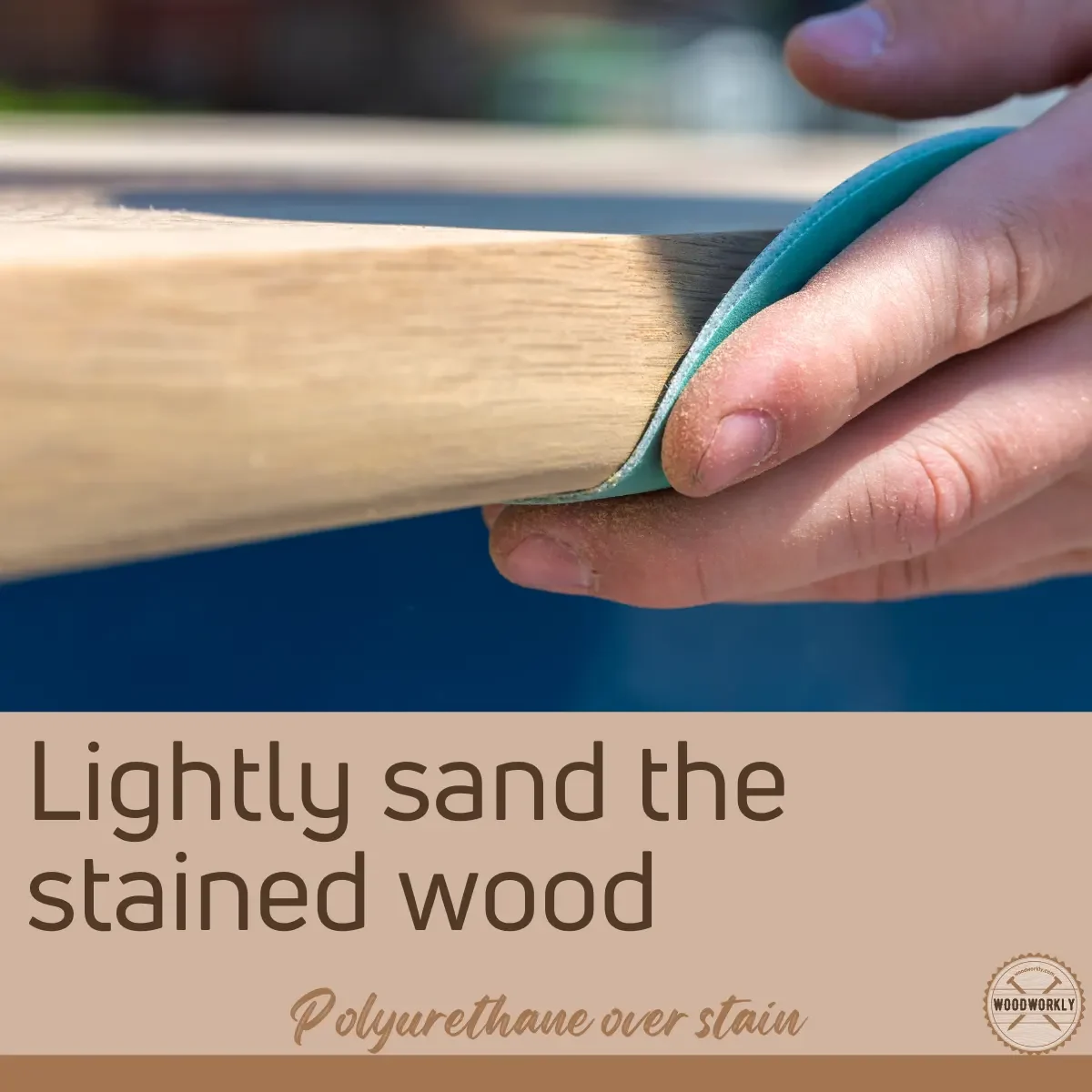
Once you’re done with sanding, clean the dust and other residues before the application of polyurethane to make the surface ready and super smooth to take on polyurethane.
5. Test The Wood Surface
Before applying polyurethane, you need to make sure the stained surface is completely dried.
In order to do that, apply 100% pure mineral spirits onto the stained surface and let it be there for 10 minutes. then, wipe off the remaining mineral spirits on the surface with a lint-free cloth.
Then check the cloth.
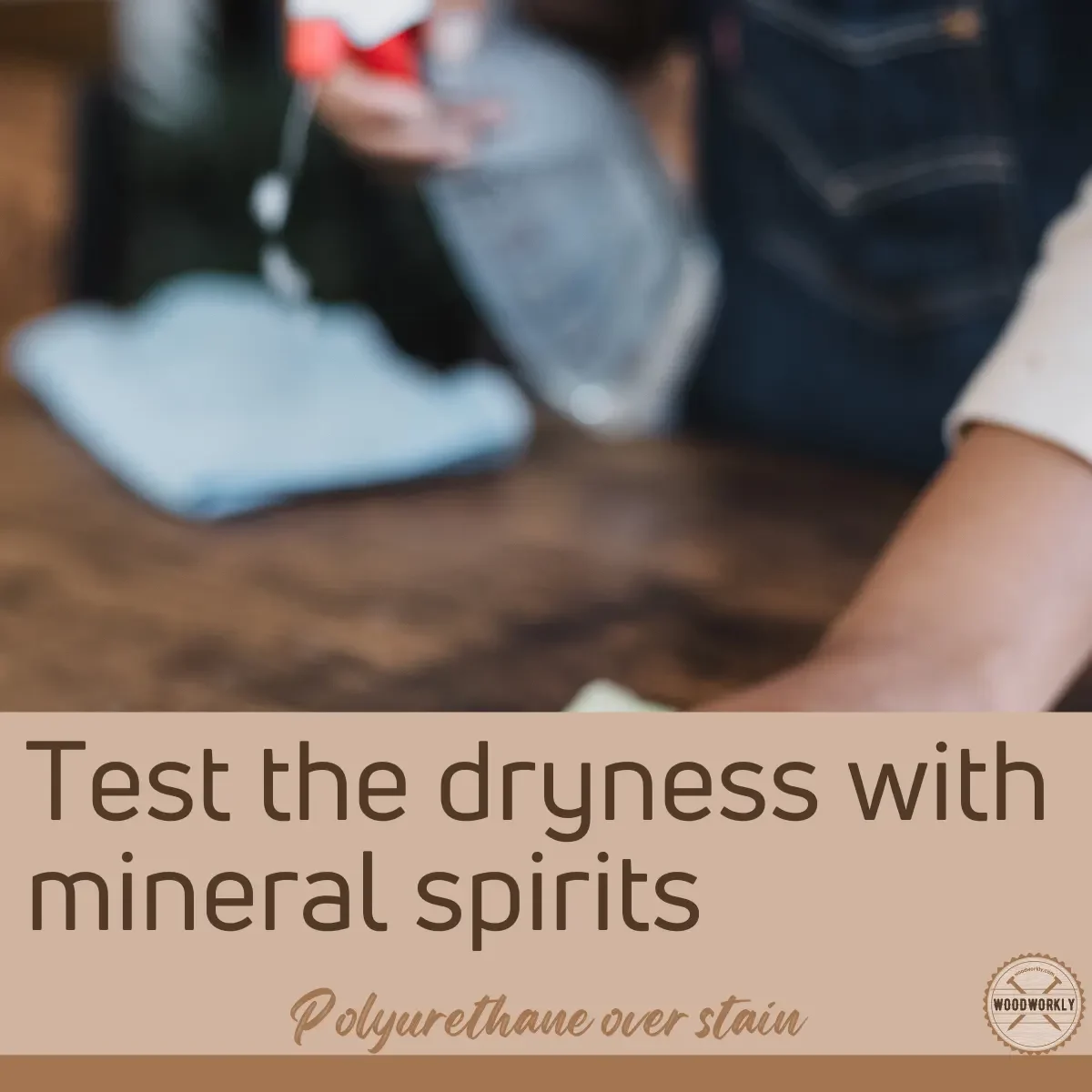
If the wood color or wood stain color leaves on it keep the stain on the wood to dry and cure for 24 hours before applying polyurethane. That resembles the wood stain that has not dried yet properly.
After 24 hours, check the stained surface again with mineral spirits. If no color leaves on the tack cloth, you are good to polyurethane the surface.
6. Apply Oil-Based Polyurethane
Take a clean bristle brush or any other applicator and apply a thin coat of polyurethane over the stained surface along the direction of the wood grain.
Apply polyurethane with even pressure on the bristle brush and follow the wood grain to make the finish even and nice.
Thin coats of polyurethane helps to avoid polyurethane mistakes like blotches and streaks.
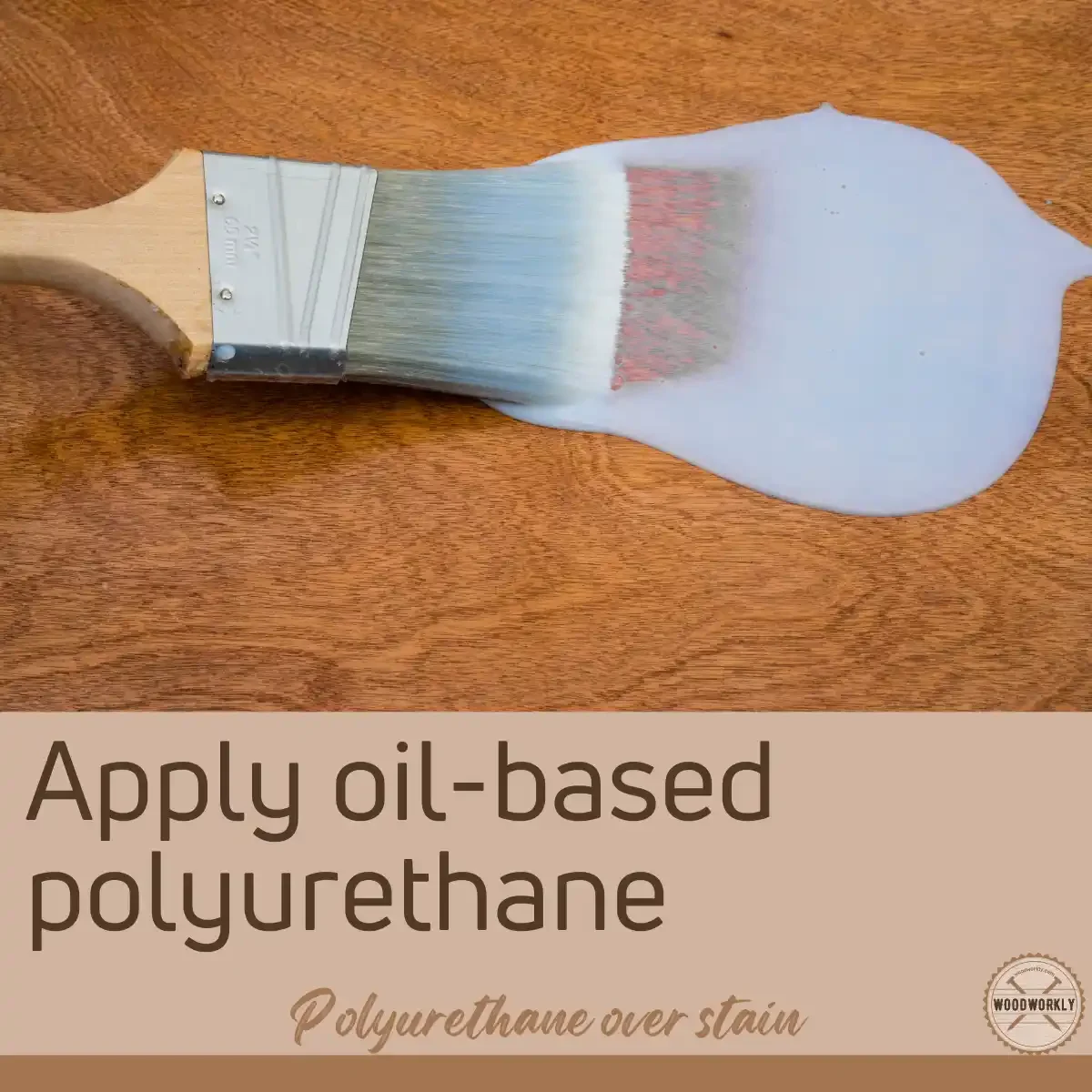
Bubbles on the surface will leave eventually upon polyurethane drying. Don’t overbrush.
7. Let The Polyurethane Dry
After applying the first polyurethane coat over stained wood, let it dry for 24 hours before applying another.
Oil-based polyurethane dries slower than water-based polyurethane. Therefore, you’ll have to wait longer after the application of the first polyurethane coat before applying another.
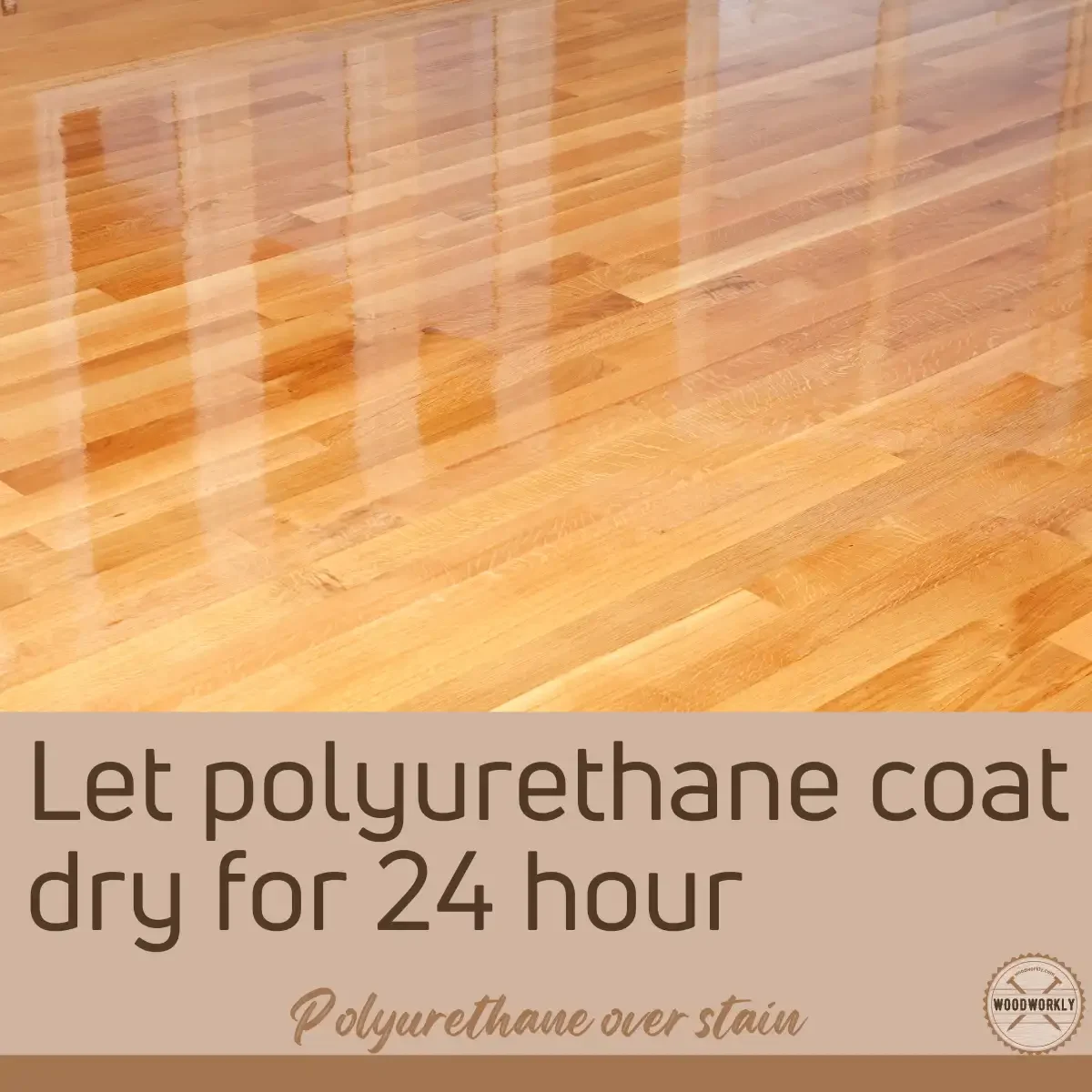
Applying polyurethane on a wet surface can ruin the wood’s appearance and reduce the performance of its protective coat.
8. Gently Sand The Polyurethane Coat
When the polyurethane coat is dried well, gently sand the polyurethane coat along the direction of the wood grain using 400 grit or finer sandpaper.
Sanding helps to give adhesive properties to the existing polyurethane coat. That helps to stick the next polyurethane coat well onto the previous one.
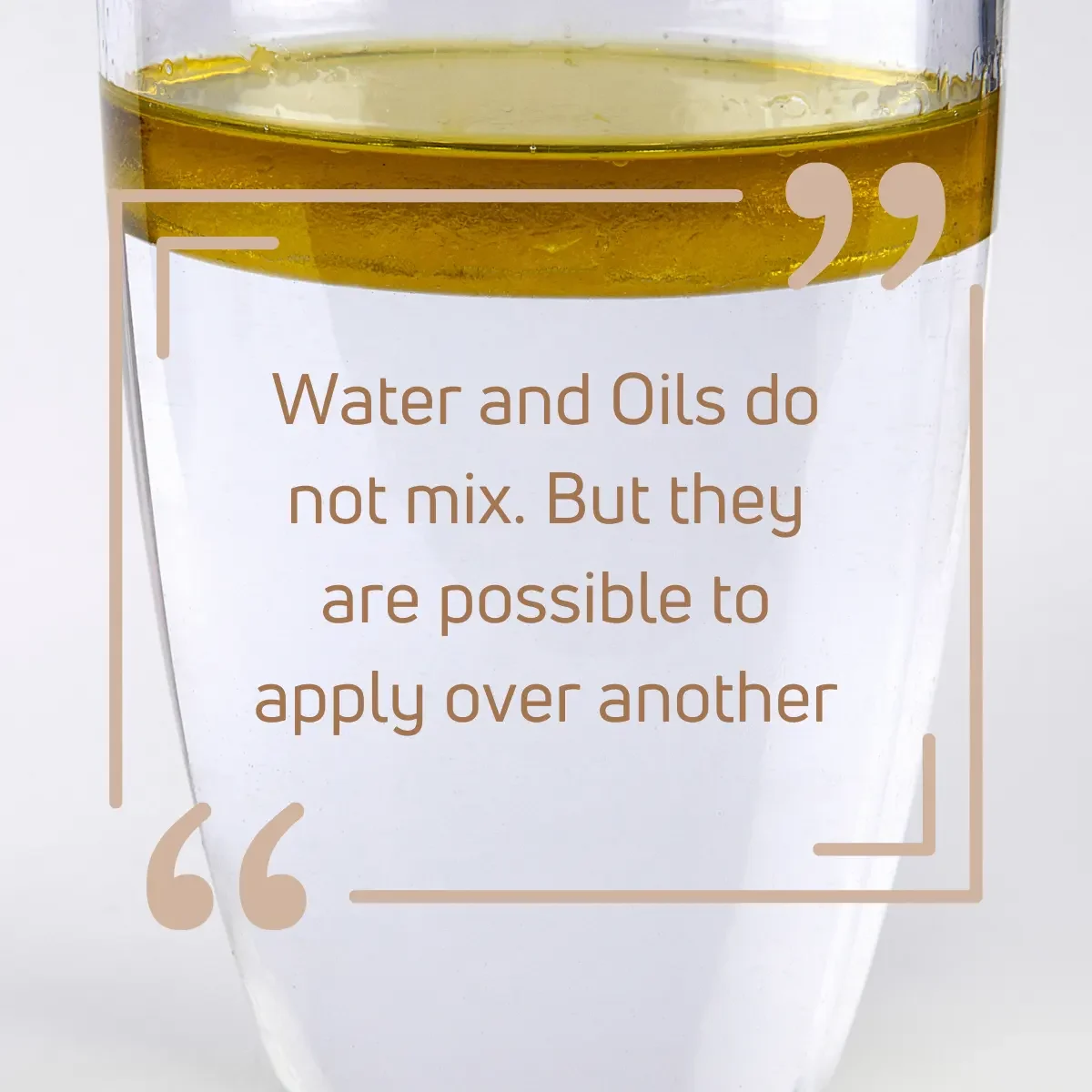
Sand lightly with even pressure to smoothen the surface without leaving scratches on the surface.
Once you’re done with sanding clean the surface with a tack cloth before applying another coat.
9. Apply More Polyurethane Coats
When the first polyurethane coat is fully dried and sanded lightly, apply more polyurethane coats until you get the finish you want.
Apply a maximum of 3 coats of polyurethane over stained wood since the surface is already finished with several stain coats and applying more and more coats slows down the drying time and can form a tacky surface.
The thickness of coats will increase upon additional coats and reduce the performance of the coats.
Apply thin coats of polyurethane and let each one dry for 24 hours before applying another.
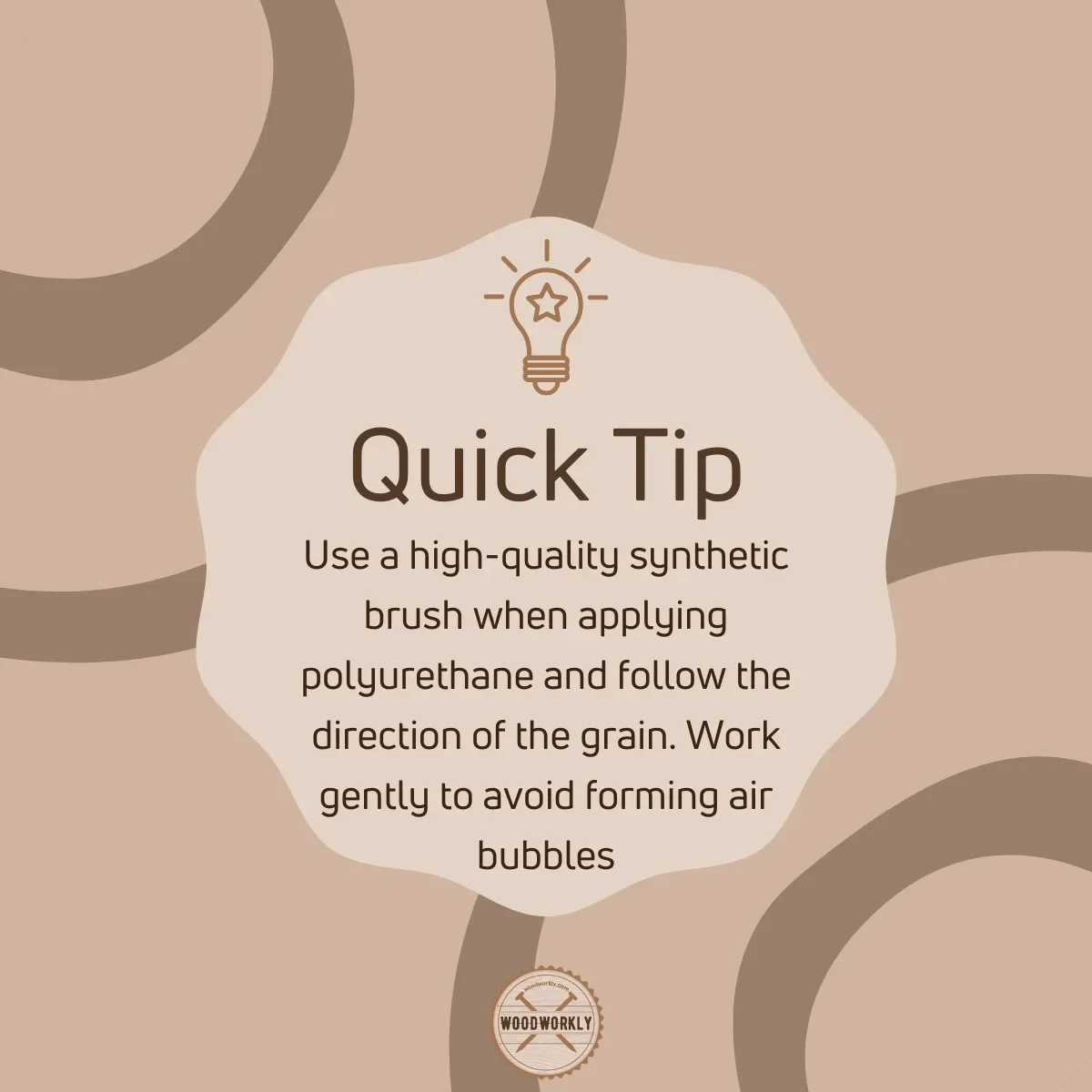
Lightly sand between each coat for better adhesion and clean and eliminate dust and dirt before every application.
After applying the final coat of polyurethane, let it dry for 24 hours and cure for 72 hours.
Check the surface upon drying to see how oil-based polyurethane gives a dark rich look to the wood while building an excellent protective coat with a glossy appearance.
That’s it, folks! Now you know if can you use oil-based polyurethane over water-based stain and how to do that properly.
Make sure to clean your polyurethane brush properly once the project is done!
How Long To Let The Stain Dry Before Applying Polyurethane?
Let the stain dry for 8 hours and cured for 72 hours before applying polyurethane. But this can vary on environmental humidity and temperature level.
The stain will take more than 8 hours up to 24 hours to dry in cooler conditions. Always check the dryness of the stained surface before applying polyurethane.
Applying polyurethane on wet stained surfaces can form a tacky surface with an unpleasant wood appearance.
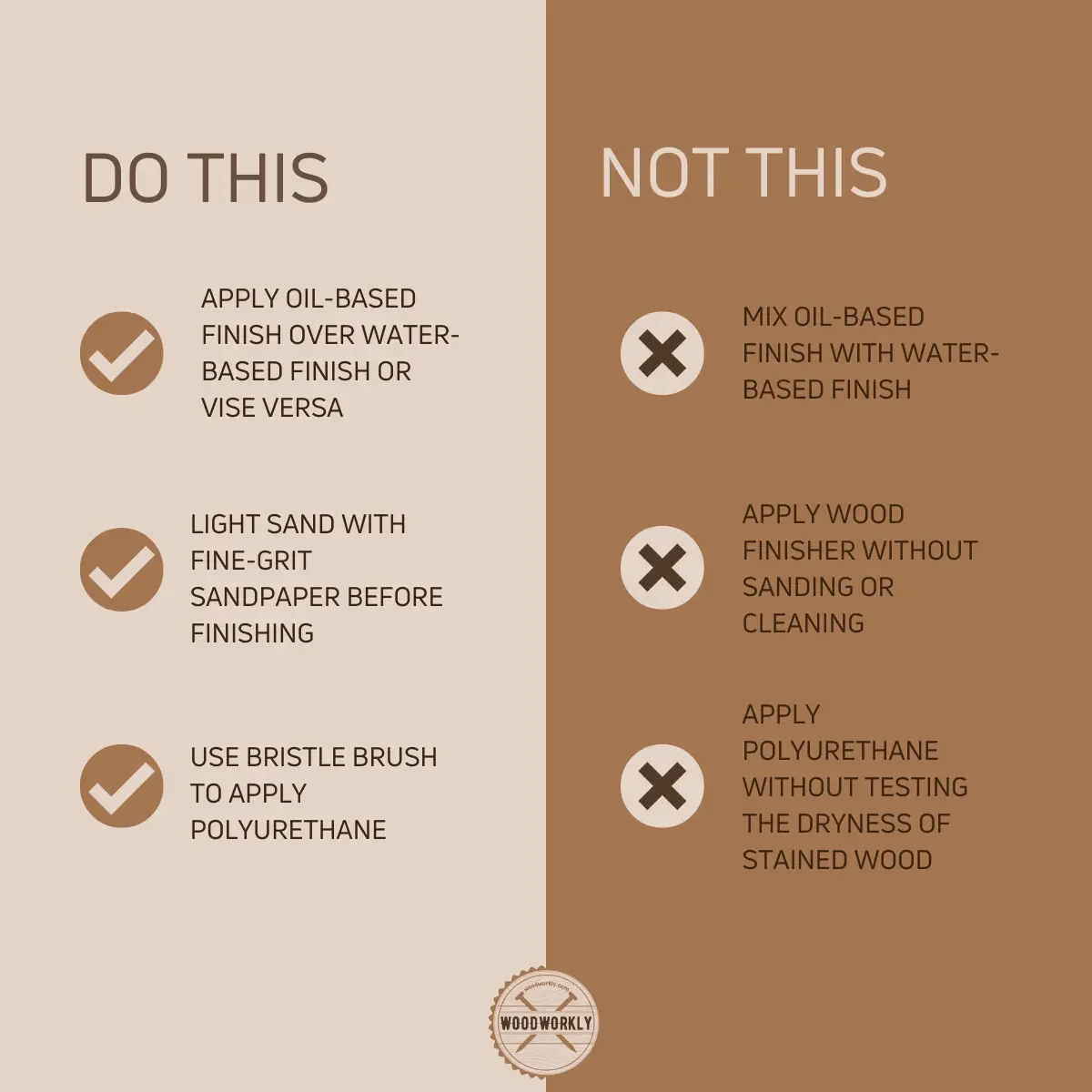
Apply a thin coat of stain to dry coats faster.
You can apply polyurethane once the stain coat is fully dried and cured. The curing time is higher than the drying time and wood will reach its final appearance after it is fully cured.
Do You Have To Sand Stain Before Applying Polyurethane?
Yes, you should sand stain before applying polyurethane. Lightly sand stained coat with 400 grit or finer sandpaper to build good adhesion between stain and polyurethane coats.
Sanding helps to smoothen the surface and helps to stick polyurethane on the stain with no layer separation.
Make sure not to leave any sanding marks or scratches during sanding because they can ruin the wood’s appearance and reduce the performance of the finishing coat.
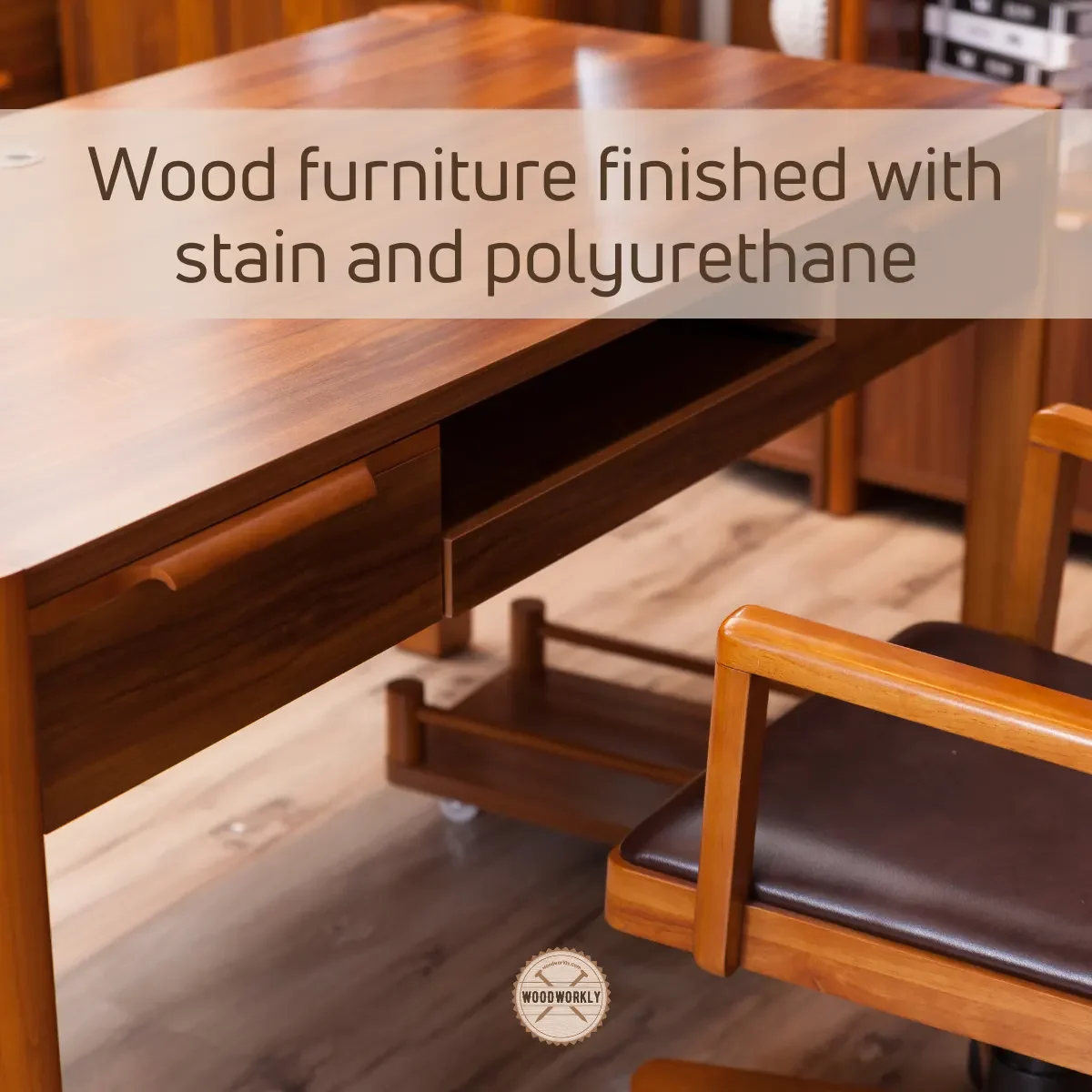
How Many Coats Of Oil-based Poly Should You Apply?
Apply 3 coats of oil-based poly over stained wood. Apply thin coats along the direction of the wood grain to spread poly evenly all over the wood surface.
Let each coat dry properly for 24 hours before applying another and lightly sand between each coat with fine-grit sandpaper to build a good adhesion between coats.
Will The Oil-based Polyurethane Change The Color Of Stained Wood?
Yes, oil-based polyurethane changes the color of stained wood to a darker deep brown color. But the difference is not highly noticeable since the wood is already stained and the stain highlights the wood grain.
There’s nothing to do to avoid oil-based polyurethane coats getting darker over time. Almost all the oil finishes get dark with age.
Most people love the dark color polyurethane gets since it adds a rich luxurious look to your furniture.
But if you don’t like it better to scrape the oil-based finish and reapply with water-based polyurethane.
Water-based polyurethane is a clear finish that does not change the color of stained wood over time.

Can You Mix Oil-Based Polyurethane With a Water-Based Stain?
You cannot mix oil-based polyurethane with water-based stain since oil medium and water medium do not mix. Mixing oil-based finish with water-based finish gives you an unpleasant globby mess with a ruined wood appearance.
They don’t blend.
You can only apply oil-based polyurethane over the water-based stain and water-based stain over oil-based polyurethane since they got adhesive properties and other coats can stick onto the surface underneath.
Is Oil-based Or Water-based Polyurethane Stronger?
Oil-based polyurethane is stronger and more durable than water-based polyurethane since it contains VOC (Volatile Organic Compounds) that help to build a protective coat over wood which is tougher, stronger, and able to last longer than bonds that form by water-based polyurethane.
But water-based polyurethane does not discolor or darken wood like oil-based polyurethane. Plus, it dries faster than oil-based poly.
Can You Use Polycrylic Over Water-based Stain?
Yes, you can apply polycrylic over a water-based stain since a water-based stain can hold a polycrylic coat. plus, polycrylic is a water-based finish like a water-based stain which is an added advantage.
Polycrylic and water-based stain mix well, blend well, and stick well. apply a thin coat of polycrylic over water-stained wood and let each coat dry well for even looking finish.
Can You Use Water-Based Polyurethane Over Oil-Based Stain?
Yes, you can use water-based polyurethane over oil-based stain since oil-based stain is able to hold water-based polyurethane well.
But they do not mix since the oil medium does not mix with the water medium. But that’s not an issue to apply over one another.
Apply thin coats of polyurethane over stained wood and let each coat dry for 8 hours and lightly sand each coat for better adhesion between the layers.
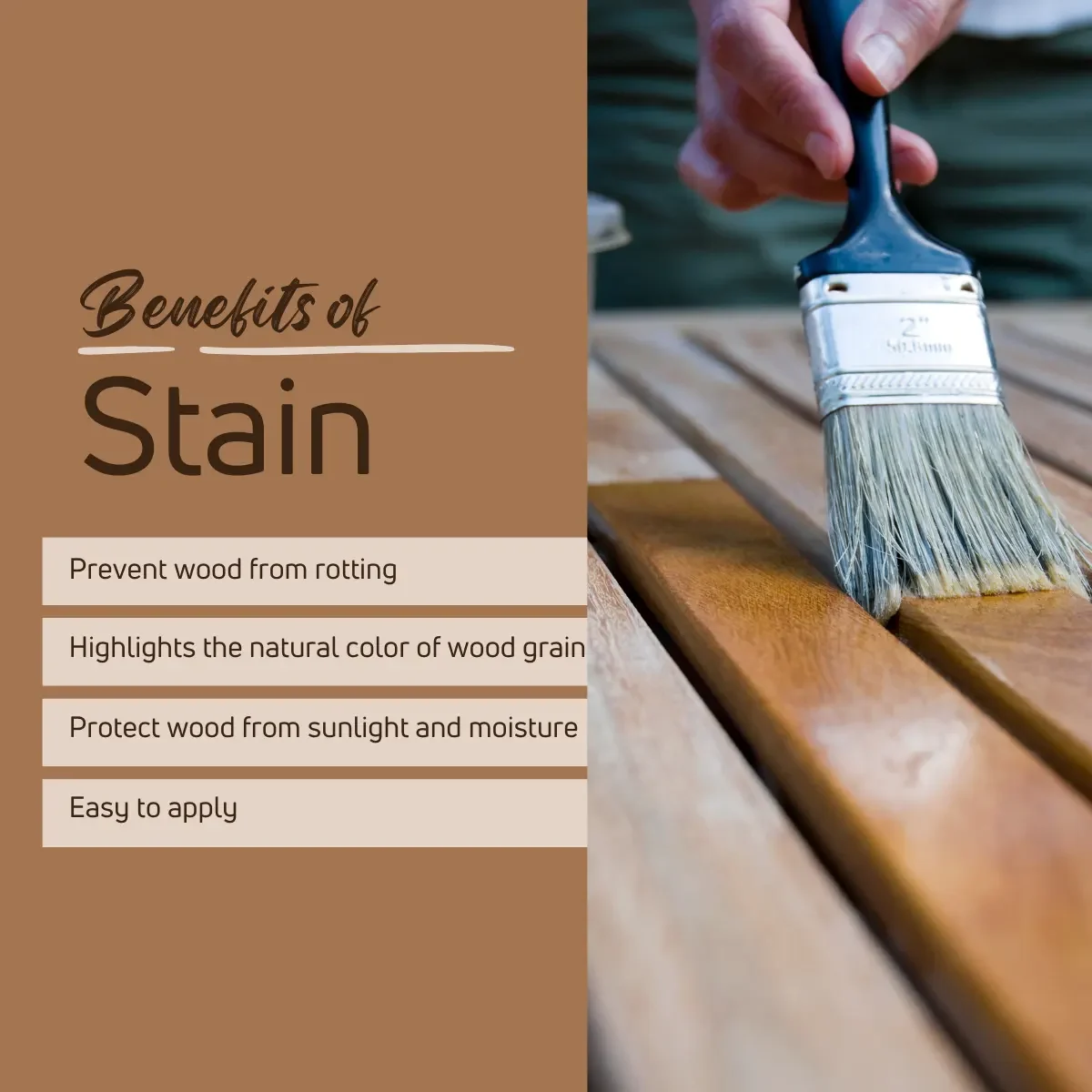
Let’s answer some frequently asked questions.
FAQs
How long should water-based stain dry before applying oil-based polyurethane?
Water-based stain should dry for at least 8 hours, and it’s advisable to allow additional drying time in cooler or more humid conditions.
Do you need to sand the water-based stain before applying oil-based polyurethane?
Yes, it’s essential to lightly sand the stained surface with fine-grit sandpaper to enhance adhesion of the oil-based polyurethane.
Can water-based and oil-based products be mixed together?
No, water-based and oil-based products cannot be mixed due to their differing chemical properties, but they can be applied in layers over each other.
Is oil-based polyurethane stronger than water-based polyurethane?
Oil-based polyurethane generally offers greater durability and water resistance compared to water-based polyurethane.
What are the safety precautions when applying oil-based polyurethane over water-based stain?
Use a respirator, ensure good ventilation, and avoid direct skin contact due to the potentially harmful fumes from oil-based polyurethane.
Did I cover all you wanted to know about: Can You Use Oil-based Polyurethane Over Water-based Stain?
In this article I discussed, whether can you use oil-based polyurethane over water-based stain and how to apply polyurethane over stained wood properly without making any mistakes.
Wood will be equipped with both polyurethane and stain finish which makes it even more durable than applying a single type of finish.
You can use oil-based polyurethane over water-based stain. Oil-based Polyurethane and water-based stain won’t mix but can be applied over each other. Apply thin coats of stain and let the stain dry well before applying polyurethane. Lightly sand between each coat for better adhesion.
Furthermore, I’ve answered some frequently asked questions as well.
Hope you learned all about it, can you use oil-based polyurethane over water-based stain with no issues.
Try to apply oil-based polyurethane over water-based stain and break the myths of wood finishing.